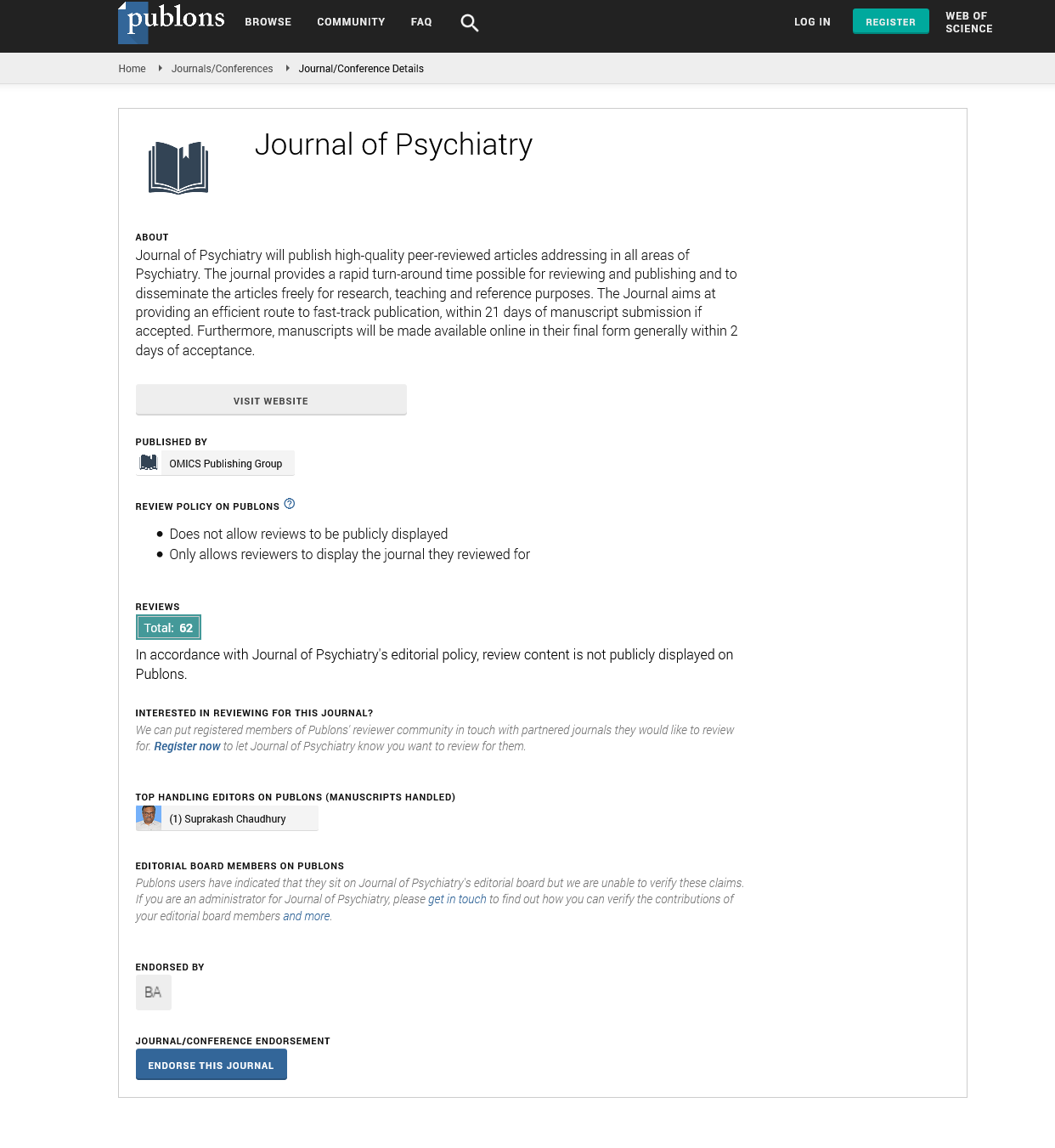Indexed In
- RefSeek
- Hamdard University
- EBSCO A-Z
- OCLC- WorldCat
- SWB online catalog
- Publons
- International committee of medical journals editors (ICMJE)
- Geneva Foundation for Medical Education and Research
Useful Links
Share This Page
Open Access Journals
- Agri and Aquaculture
- Biochemistry
- Bioinformatics & Systems Biology
- Business & Management
- Chemistry
- Clinical Sciences
- Engineering
- Food & Nutrition
- General Science
- Genetics & Molecular Biology
- Immunology & Microbiology
- Medical Sciences
- Neuroscience & Psychology
- Nursing & Health Care
- Pharmaceutical Sciences
Perspective - (2024) Volume 27, Issue 1
Insomnia and Anxiety: A Cognitive Behavioral Therapy Approach
Lan Shan*Received: 02-Jan-2024, Manuscript No. JOP-24-24706; Editor assigned: 05-Jan-2024, Pre QC No. JOP-24-24706 (PQ); Reviewed: 19-Jan-2024, QC No. JOP-24-24706; Revised: 25-Jan-2024, Manuscript No. JOP-24-24706 (R); Published: 02-Feb-2024, DOI: 10.35248/2378-5756.24.27.666
Description
Insomnia and anxiety often coexist, creating a challenging cycle where one condition exacerbates the other. Cognitive Behavioral Therapy for Insomnia (CBT-I) has emerged as a encouraging and effective approach in addressing both insomnia and anxiety, offering individuals a comprehensive framework to improve sleep and alleviate associated psychological distress. Insomnia, characterized by difficulty falling asleep, staying asleep, or experiencing non-restorative sleep, is intricately linked with anxiety. Individuals with anxiety may find their thoughts inundated with worries and intrusive thoughts, making it challenging to achieve a calm and relaxed state conducive to sleep. On the other side, insufficient or disrupted sleep can heighten anxiety levels, creating a detrimental feedback loop that perpetuates both conditions.
CBT-I, a structured and evidence-based therapeutic approach, targets the cognitive and behavioral factors contributing to insomnia. This approach recognizes the bidirectional relationship between insomnia and anxiety, addressing both the cognitive and physiological aspects that fuel the cycle. One key component of CBT-I is cognitive restructuring, which involves identifying and challenging maladaptive thoughts and beliefs about sleep. Individuals with insomnia often develop negative associations with bedtime, viewing it as a struggle where sleep must be fought for. This negative mindset can contribute to heightened anxiety about sleep, further hindering the ability to relax and fall asleep.
Through cognitive restructuring, individuals learn to reframe these negative thoughts and develop more balanced and realistic beliefs about sleep. This process involves challenging irrational beliefs, such as catastrophic thinking about the consequences of a poor night's sleep, and replacing them with more adaptive and constructive thoughts. By addressing these cognitive distortions, CBT-I helps reduce anxiety associated with sleep and fosters a healthier mindset. Another important element of CBT-I is stimulus control, which aims to associate the bed with sleep and break the association between the bedroom and wakefulness. This involves implementing strict guidelines, such as using the bed only for sleep and intimacy, avoiding stimulating activities in bed, and getting out of bed if unable to sleep within a set timeframe. By reinforcing the connection between the bed and sleep, stimulus control helps reduce anxiety and create a more conducive sleep environment.
Sleep restriction, another component of CBT-I, involves optimizing the sleep-wake schedule to improve sleep efficiency. This approach initially restricts the time spent in bed to match the individual's average sleep duration, gradually increasing it as sleep efficiency improves. By consolidating sleep and minimizing time spent in bed awake, sleep restriction helps regulate the sleep-wake cycle, promoting more restful sleep and reducing anxiety around bedtime. CBT-I also incorporates relaxation techniques to address the physiological arousal associated with anxiety. Progressive muscle relaxation, deep breathing exercises, and guided imagery are commonly used to help individuals achieve a state of calm and relaxation conducive to sleep. These techniques not only counteract the physiological effects of anxiety but also provide individuals with practical tools to manage stress and anxious thoughts throughout the day.
In addition to these components, CBT-I may involve sleep hygiene education to promote healthy sleep habits. This includes recommendations such as maintaining a consistent sleep schedule, creating a comfortable sleep environment, and minimizing stimulating activities close to bedtime. While not the sole focus of treatment, addressing these behavioral factors can contribute to overall improvements in sleep and anxiety.
The effectiveness of CBT-I in addressing both insomnia and anxiety has been well-documented in research studies. Compared to pharmacological interventions, CBT-I has shown sustained benefits with lower risks of side effects and dependency. Moreover, the skills acquired through CBT-I is empowering, providing individuals with long-term tools to manage sleep and anxiety independently. It's important to note that CBT-I is typically delivered by trained professionals, such as psychologists or sleep specialists, but there are also self-help resources and online programs that individuals can explore under guidance. Customizing the approach to the unique needs and circumstances of each individual is essential for its success.
In conclusion, the intricate relationship between insomnia and anxiety requires a comprehensive therapeutic approach, and Cognitive behavioral therapy for Insomnia emerges as a valuable tool in breaking the cycle. By addressing maladaptive thoughts, implementing behavioral strategies, and incorporating relaxation techniques, CBT-I not only improve sleep but also mitigate the anxiety intertwined with the insomnia experience. As a comprehensive and empowering intervention, CBT-I offers individuals a path towards better sleep, reduced anxiety, and improved overall well-being.
Citation: Shan L (2024) Insomnia and Anxiety: A Cognitive Behavioral Therapy Approach. J Psychiatry. 27:666.
Copyright: © 2024 Shan L. This is an open access article distributed under the terms of the Creative Commons Attribution License, which permits unrestricted use, distribution, and reproduction in any medium, provided the original author and source are credited.

